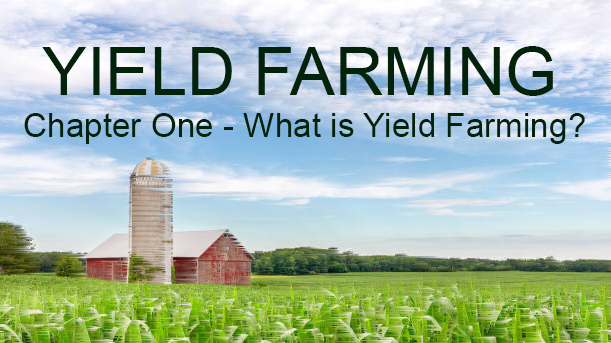Yield Farming Chapter One - What is Yield Farming?

This is chapter one in a series of articles that will be released about yield farming. The purpose of this series is to introduce the concept of yield farming to those who are unfamiliar with it, then move into various yield farming strategies and finally step-by-step walkthrough of the process. I hope you enjoy the series and any feedback you have would be greatly appreciated.
Chapter One - What is Yield Farming?
Yield (verb) produce or provide
Farming (noun) the activity or business of growing crops
Yield Farming is an investment strategy used in cryptocurrency used to maximize returns on assets leveraging Decentralized Finance (DeFi). There are three main methods used in yield farming to generate returns.
1) Staking - is the simplest form of yield farming and often the safest method as well. Staking involves holding your coins or tokens on a blockchain that offers proof-of-stake (POS) and offers rewards in terms of interest. Some of the bigger cryptocurrencies currently offer POS including Cardona (CAR), Solana (SOL) and Polkadot (DOT). Ethereum (ETH) is also in the process of moving to a POS consensus and Ethereum 2.0 will offer staking rewards. Many exchanges offer staking including Coinbase and Crypto.com.
2) Lending - is the process in which cryptocurrency holders lend out their coins or tokens to borrowers. A number of platforms exist that allow lenders to deposit cryptocurrency and then loan it out receiving interest as a reward. The loan is usually backed by collateral held in terms of a borrower's other cryptocurrencies totaling more than the amount borrowed and the loan is managed by a smart contract. One can gain further gains through leveraged lending which gets more risky. Platform examples include Aave and Compound.
3) Liquidity Providing - is when users combine two coins or tokens into a Liquidity Pool (LP) tokens which allows investors to swap between the two tokens. For providing this liquidity, users are rewarded from the fees paid to perform a swap from one token to another based on what percentage of the overall pool one owns. The LP tokens held must remain in a 50/50 balance in terms of value so the underlying coins in a LP token are constantly shifting. Platform examples include Uniswap and PancakeSwap.
What are the benefits of yield farming?
Holding a cryptocurrency is similar to owning a stock in the fact that your gain or loss is typically determined by the price movement of the underlying asset. As cryptocurrencies become more and more correlated to the movement of the stock market, they offer less and less diversification in a portfolio consisting of stocks or mutual funds.
Yield Farming offers a way for one to earn "yield" and build up holdings in cryptocurrencies. In many ways, it is more similar to holding a bond or a dividend paying stock but with the upside (or downside) of a growth stock. In bull markets, yield farming provides a way of increasing your underlying asset and boosting returns as the underlying cryptocurrency price increases. In bear markets, yield farming provides "passive income" which can help offset losses caused by the price depreciation of cryptocurrencies.
The yield earned at a bank is typically 1% or less a year while the yields earned in yield farming can be in double, triple or even quadruple-digit returns.
What are the risks of yield farming?
As with simply holding cryptocurrency, the risk of a decrease in the price of the asset is ever present. The risk of the platform holding the assets failing is also present and potentially heightened in the DeFi protocols that offer yield farming and no insurance typically exists. Scams and "rug pulls" can also result in lost assets due to the decentralized nature of the platforms used. These are true of staking, lending and liquidity providing. Lending adds the risk of the smart contract failing and not being repaid.
Liquidity providing adds the risk of impermanent loss which will be detailed in a further article. In short, impermanent loss exist because of the 50/50 ratio of the underlying two cryptocurrencies held in a LP token. The loss comes from the fact that you will end up holding more of the coin that has less value than the other coin when you decide to sell or split up the LP token. Impermanent loss does scare off many from getting involved in liquidity providing, however, the risk can be minimized through various strategies that will be discussed in a later chapter.
Who should get involved in yield farming?
While some investors play a short-game chasing high initial yields in farms, those with a long-term strategy in cryptocurrency are best suited for yield farming. If you are holding coins for the long-term, why not grow the number of coins over time and boost your returns?
Yield Farming also offers a much deeper dive into cryptocurrency and will expand your knowledge of the space significantly. It will help you diversify your cryptocurrency holdings allowing you to maximize gains during a bull market and lower losses during a bear market. It is more complex than simply buying coins so make sure to do plenty of research and start small with risk capital you are comfortable losing.
Whiteboard Crypto YouTube Video - What is Yield Farming in Crypto?